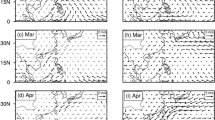Abstract
The role of halted “baroclinic modes” in the central equatorial Pacific is analyzed. It is found that dominant anomaly signals corresponding to “baroclinic modes” occur in the upper layer of the equatorial Pacific, in a two-and-a-half layer oceanic model, in assimilated results of a simple OGCM and in the ADCP observation of TAO. A second “baroclinic mode” is halted in the central equatorial Pacific corresponding to a positive SST anomaly while the first “baroclinic mode” propagates eastwards in the eastern equatorial Pacific. The role of the halted second “baroclinic mode” in the central equatorial Pacific is explained by a staged ocean-atmosphere interaction mechanism in the formation of El Niño: the westerly bursts in boreal winter over the western equatorial Pacific generate the halted second “baroclinic mode” in the central equatorial Pacific, leading to the increase of heat content and temperature in the upper layer of the central Pacific which induces the shift of convection from over the western equatorial Pacific to the central equatorial Pacific; another wider, westerly anomaly burst is induced over the western region of convection above the central equatorial Pacific and the westerly anomaly burst generates the first “baroclinic mode” propagating to the eastern equatorial Pacific, resulting in a warm event in the eastern equatorial Pacific. The mechanism presented in this paper reveals that the central equatorial Pacific is a key region in detecting the possibility of ENSO and, by analyzing TAO observation data of ocean currents and temperature in the central equatorial Pacific, in predicting the coming of an El Niño several months ahead.
Similar content being viewed by others
References
Battisti, D. S., 1988: The dynamics and thermodynamics of a warming event in a coupled tropical atmosphereocean model. J. Atmos. Sci., 45, 2899–2919.
Boulanger, J. P., 2001: The Trident Pacific Model. Part 1: Simulating surface ocean currents with a linear model during the 1993–1998 TOPEX/POSEIDON period. Climate Dyn., 17, 159–173.
Carton, J. A., G. Chepurin, X. Cao, and B. S. Giese, 2000: A Simple Ocean Data Assimilation analysis of the global upper ocean 1950–1995, Part 1: Methodology. J. Phys. Oceanogr., 30 294–309.
Chen Xingyue, Wang Huijun, Xue Feng, and Zeng Qingcun, 2001: Intraseasonal Oscillation: The global co-incidence and its relationship with ENSO cycle. Adv. Atmos. Sci., 18, 445–453.
Claire Perigaud, 1990: Sea level oscillations observed with Along the two shear fronts of the Pacific North Equatorial Countercurrent. J. Geophys. Res., 95, 7239–7248.
Dewitte, B., G. Reverdin, and C. Maes, 1999: Vertical structure of an OGCM simulation of the equatorial Pacific Ocean in 1985–94. J. Phys. Oceanogr., 29, 1542–1570.
Hirst, A. C., 1986: Unstable and damped equatorial modes in simple coupled ocean-atmosphere models. J. Atmos. Sci., 43, 606–630.
Lau, K. M., and P. H. Chan, 1986: The 40–50 day oscillation and the El Niño Southern Oscillation. Bull. Amer. Meteor. Soc., 67, 533–534.
Liu Qinyu, and Qin Zenghao, 1994: Coupled Ocean-Atmosphere characteristics in three El Nino events. Oceanologia et Limnologia Sinica, 25, 636–642. (in Chinese)
McCreary, J. P., and Z. Yu, 1992: Equatorial dynamics in a 2 1/2 layer model. Prog. Oceanogr., 29, 61–132.
McPhaden, J. M., 1999: Genesis and evolution of the 1997–98 El Niño. Science, 283, 950–954.
NOAA/National Weather Service, 1995: Climate diagnostics Bulletin, Monthly Series (July). USA, 38pp.
NOAA/National Weather Service, 1998: Climate diagnostics Bulletin, Monthly Series (July). USA, 43pp.
Philander, S. G. H., 1983: El Niño, Southern Oscillation phenomena. Nature, 302, 296–301.
Philander, S. G. H., 1990: El Niño, La Niña and the Southern Oscillation. Academic Press, 289pp.
Rasmusson, E. M., and T. H. Carpenter, 1982: Variations in tropical sea surface temperature and surface wind field associated with the Southern Oscillation/El Niño. Mon. Wea. Rev., 110, 354–384.
Sun, J., Q. Liu, and B. Zhu, 1997: Anomaly in tropical Pacific and its affection on El Niño. Recent Advances in Marine Science and Technology, ’96, N. Saxene, Ed. Hawaii, 239-248.
Sun, J., and L. Li, 1998: Some characteristics of low frequency oscillations in the equatorial Pacific. Journal of Ocean University of Qingdao, 3, 363–369.
van Oldenborgh, G., 2000: What caused the onset of the 1997/98 El Niño. Mon. Wea. Rev., 128, 2601–2607.
Zebiak, S. E., and M. A. Cane, 1987: A model ENSO/Southern Oscillation. Mon. Wea. Rev., 115, 2262–2278.
Author information
Authors and Affiliations
Rights and permissions
About this article
Cite this article
Sun, J., Chu, P. & Liu, Q. The role of the halted baroclinic mode at the central equatorial Pacific in El Niño event. Adv. Atmos. Sci. 23, 45–53 (2006). https://doi.org/10.1007/s00376-006-0005-6
Received:
Revised:
Issue Date:
DOI: https://doi.org/10.1007/s00376-006-0005-6



